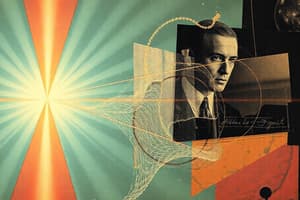Podcast
Questions and Answers
What does the threshold wavelength (
λo) represent in the context of the photoelectric effect?
What does the threshold wavelength ( λo) represent in the context of the photoelectric effect?
- The wavelength corresponding to the most energetic photon
- The maximum wavelength of incident radiation that can cause photoelectric emission (correct)
- The wavelength at which light intensity is at its peak
- The minimum energy needed to remove an electron from the metal
Which formula correctly represents the stopping potential (
Vo) in terms of the work function (
Φ) and energy (
E)?
Which formula correctly represents the stopping potential ( Vo) in terms of the work function ( Φ) and energy ( E)?
- Vo = (E - Φ) / e (correct)
- Vo = hc / λ + Φ
- Vo = (E + Φ) / e
- Vo = hc / eλ
What is the relationship between the intensity of light and the maximum kinetic energy (
Kmax) of emitted photoelectrons?
What is the relationship between the intensity of light and the maximum kinetic energy ( Kmax) of emitted photoelectrons?
- Kmax decreases with increased intensity
- Kmax remains constant regardless of intensity (correct)
- Kmax is inversely proportional to intensity
- Kmax increases with increased intensity
In the formula λ = h / p, what does the variable 'p' represent?
In the formula λ = h / p, what does the variable 'p' represent?
Which of the following statements is true regarding the photoelectric effect?
Which of the following statements is true regarding the photoelectric effect?
What does the variable 'λ' signify in the context of the De Broglie wavelength?
What does the variable 'λ' signify in the context of the De Broglie wavelength?
How is the maximum kinetic energy (
Kmax) of an emitted photoelectron calculated?
How is the maximum kinetic energy ( Kmax) of an emitted photoelectron calculated?
What constant is combined with the speed of light in the equation for the threshold wavelength?
What constant is combined with the speed of light in the equation for the threshold wavelength?
Flashcards
Photoelectric Effect
Photoelectric Effect
The process of emitting electrons from a metal surface when light of a certain frequency shines on it.
Threshold Wavelength
Threshold Wavelength
The maximum wavelength of light capable of causing photoelectric effect, where the minimum energy is required to eject an electron from the metal surface.
De Broglie Wavelength
De Broglie Wavelength
The wavelength associated with a moving particle, demonstrating the wave-particle duality of matter.
Stopping Potential
Stopping Potential
Signup and view all the flashcards
Work Function
Work Function
Signup and view all the flashcards
Photon Energy
Photon Energy
Signup and view all the flashcards
Maximum Kinetic Energy of Photoelectrons
Maximum Kinetic Energy of Photoelectrons
Signup and view all the flashcards
Wave-Particle Duality
Wave-Particle Duality
Signup and view all the flashcards
Study Notes
Photoelectric Effect
- The minimum amount of energy required to eject an electron from a metal surface is called the work function.
- Work function is measured in electron volts (eV).
- Work function depends on the nature of the metal.
- Threshold wavelength (λ₀) is the maximum wavelength of light required to cause the photoelectric effect.
- Kinetic energy (K.E.) of emitted electrons is related to the frequency (f) of incident radiation and the work function (Φ) by the equation: K.E. = hf – Φ, where h is Planck's constant.
- Increasing the intensity of the incident light increases the number of emitted electrons, but the kinetic energy of each electron remains unchanged.
- Threshold frequency (f₀) is the minimum frequency of incident radiation required to eject electrons.
- Einstein's photoelectric equation: K.E. = hf – Φ
- The maximum kinetic energy of emitted photoelectrons (K.E.)max is directly proportional to the frequency (f) of incident light and inversely proportional to the wavelength (λ).
- Stopping potential (V₀) is the minimum negative potential required to stop the most energetic photoelectrons from reaching the anode.
Threshold Wavelength
- The maximum wavelength or longest wavelength of incident radiation that can cause the emission of electrons is called the threshold wavelength.
- Threshold wavelength is inversely proportional to the work function
- Equation: λ₀ = hc/Φ, where h is Planck's constant, c is the speed of light.
Threshold Frequency
- The minimum frequency of incident radiation needed to cause the emission of electrons from a metal surface is called the threshold frequency (f₀)
- Equation: f₀ = Φ/h, where Φ is the work function and h is Planck's constant
Einstein's Photoelectric Equation
- Relates the kinetic energy of emitted electrons to the frequency of incident light and the work function of the metal.
- Equation: Kmax = hf - Φ
Stopping Potential
- The minimum negative potential required to stop the most energetic electrons from reaching the anode is called the stopping potential.
- The stopping potential is related to the maximum kinetic energy of the emitted electrons by the equation: eV₀ = Kmax, where e is the elementary charge.
Photoelectric Effect - Summary
- Instantaneous phenomenon
- Selective frequency of radiation needed
- Kinetic energy (K.E) = Energy (E) - Work Function (Φ)
- Photoelectrons are emitted when light strikes a metal surface
Studying That Suits You
Use AI to generate personalized quizzes and flashcards to suit your learning preferences.




